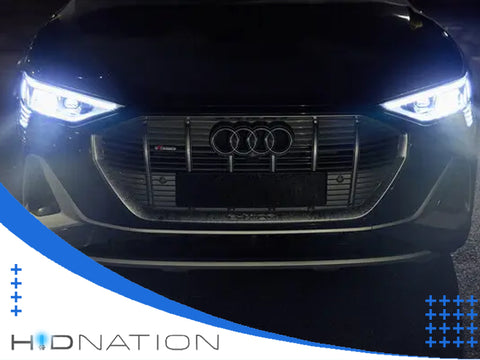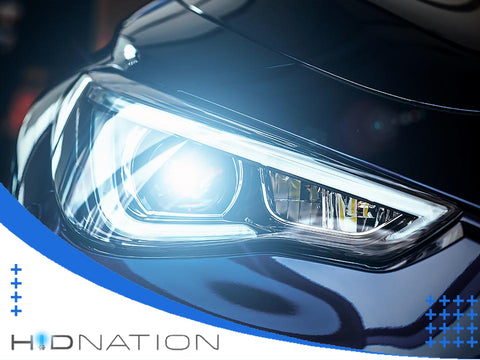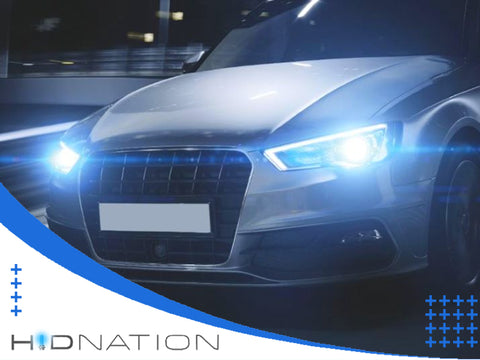Car lighting rapidly evolves into illumination that can affect comfort and safety and help transition to an autonomous future.
Ambient lighting is a growing trend in auto interiors because it provides a pleasant environment for drivers and passengers to enjoy. It also helps increase driver orientation during dusk and nighttime driving.
1. LED Headlights
LED headlights are changing the automotive lighting landscape, offering drivers a better way to see at night. Compared to traditional halogen headlights, LED lights have higher light output and a broader beam pattern. They also produce less glare than halogens.
These lights have become a commonplace addition to new vehicles and are quickly replacing halogen bulbs on many models. While halogens are still popular, they're less efficient or durable than LEDs.

Unlike traditional incandescent bulbs, LEDs don't need to warm up before they can be used. This saves energy and allows them to light up faster, which helps the driver respond more quickly to rear-end collisions.
In addition, LEDs have a more natural-looking color than HIDs, making them ideal for drivers who want to customize their car's appearance. In fact, some automakers are using H11 LED headlights on their high-end models to help them stand out from the crowd.
For example, Audi, BMW, and Toyota have all developed vehicles with high-quality LED headlights that are small and unobtrusive. This helps the cars look more sleek and modish.
Another reason why some automakers are switching to LEDs is because they are a cheaper alternative to HID conversion kits. In addition, the technology can help reduce energy costs and improve the environment.
Before switching to LEDs, however, you should consider your lighting preferences and the laws in your area. Not all states allow aftermarket conversions, and you should check with your local government to ensure it's legal to change your headlights.
2. Ambient Lighting
Ambient lighting is a new feature that has become increasingly popular among automakers. It uses lights mounted around the cabin to create a more comfortable and inviting experience for drivers and passengers. It often pulsates to music from the audio system for added customization. In addition, it can illuminate cupholders, foot wells, door dashes, door trim, and speaker surrounds.

It also provides a more spacious feel in the vehicle cabin, which can be appealing to consumers in the luxury and premium segments. Additionally, it may help soothe and comfort drivers and passengers during long journeys or while driving at night.
Most ambient lighting systems are a standard feature, but some allow users to tailor the color and adjust the brightness. Some even pulsate to the beat of the music for an exciting dance-party vibe.
In addition to offering drivers a more relaxing and comfortable experience, some automakers use ambient lighting as a marketing tool for their vehicles. This can lead to increased sales of their vehicles and a better brand image.
While some ambient lighting systems are subtle, others can get pretty bright, like in newer Mercedes and BMW models. Some are also able to change colors slowly as you drive.
This is a great way to add a touch of class to your vehicle without spending a lot of money. You can find it in many different vehicles, so make sure to check out what your options are before you buy!
It offers an innovative way to light up a vehicle’s interior and is becoming more common in both new and used cars. With so many different types of LEDs available, it is easy to customize your car with lighting that matches your personal style.
3. Matrix LED Lighting
Matrix LED Lighting is an advanced automotive lighting technology changing how drivers see the road. This new technology allows vehicle manufacturers to create various light patterns, including glare-free and adaptive front lights.

Another Matrix LED lighting feature is the ability to use a computer to control the individual LEDs, creating unlimited real-time pattern control and animation. This enables using more unique and exciting LED shapes, colors, and designs.
With its LT3965 matrix LED driver, Infineon has the right IC solution to take the next step in the automotive lighting world.
4. Adaptive Headlights
Adaptive headlights improve night driving safety by using sensors to automatically change their beams when they detect an obstacle on the road. They also adjust to changes in light conditions, such as fog or rain.

They are particularly beneficial when driving around curves, as they can help illuminate the road and avoid potential accidents.
How Adaptive Headlights Work?
Adaptive headlights use several sensors that detect your car's speed, direction, and distance as it navigates a curve.
Then, the beams are triggered to move to a specified range of motion – 15 or 30 degrees, depending on the system. This allows you to see better what is around the curve while limiting glare to other vehicles.
If you notice something unusual on the road or near your car, slow down or swerve to avoid an accident.
5. OLED Lights
Several lighting technologies are changing how vehicles are made and operated in the automotive industry. One of those technologies is OLED lights, an excellent option for many consumers.
OLED lighting is also very energy-efficient, consuming less power than traditional LEDs. In addition, OLEDs are very environmentally friendly since they do not contain any UV rays or yellow phosphors.
While this technology has some limitations, it is an exciting new way to illuminate a vehicle. Audi's technology uses OLEDs to create a "swarming" effect on the front of a car, meaning that the lights move synchronously with the wheel's movement.
Therefore, the technology should not be used for a while. Another promising area for OLED lighting is as a decorative accent.
Other possible uses include lighted wraps for architectural elements such as columns, walls, and beams.
Conclusion
With the latest advancements in driver technology, it is easy to design and manufacture advanced matrices of LEDs that can be individually controlled. This enables the creation of an endless number of different light patterns that can be used to improve driver safety, visibility, and comfort.
Read Also: Importance of Automotive Lighting – Create a More Intuitive Driving Experience
FAQs
What Are the Latest Trends in Automotive Lighting?
Modern lighting technology has been a global mega-trend since it opens up new car design and performance horizons.
Recent advances in LED technology, driver modules, and optical materials are transforming the world of vehicle exteriors. This enables arrayed light displays that are much more than just road lights.
What is Lighting System in Automotive?
A vehicle's lighting system serves to illuminate the roadway, provide visibility for other road users and increase the driver’s sense of direction.
Automotive lighting technology has evolved rapidly to make these systems more automated, responsive, efficient, durable, visible, safe, and aesthetically pleasing to drivers and passengers. Optical modeling and simulation are essential for these advancements.
What Are the External Lights in a Car?
Automotive exterior lighting ensures the driver's visibility in road traffic and increases other drivers' recognition of a vehicle's presence, size, position, speed, direction of travel, and intentions.
Many newer cars feature modern, brighter LED headlamps. They use less energy than conventional halogen and filament bulbs and last longer, producing more light in less space.
What Are the Components of the Automotive Lighting System?
The lights on your vehicle are designed to help you see better at night, signal traffic, and be visible to other drivers.
In addition to headlights, your vehicle may also have side markers. These lights illuminate the sides of your vehicle to alert other drivers that you are about to turn or change lanes.
Which Type of Light is Best For Car?
The best type of light for your car depends on what you want to achieve. You want to make sure you choose a style that looks good and is safe for other road users.
Xenon and LED lights are two of the most popular options. However, both have their pros and cons.



